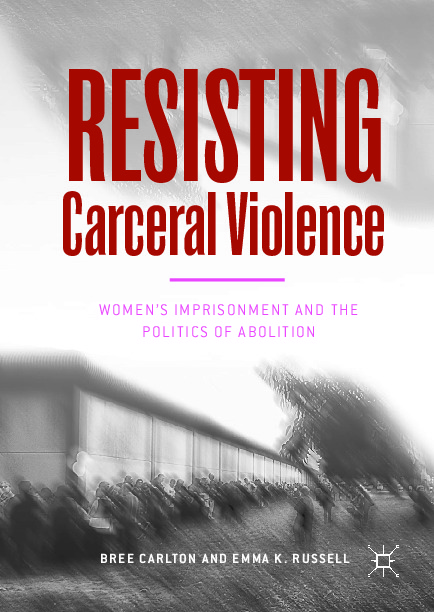File #2369: "2018_Book_ResistingCarceralViolence.pdf"
Testo
1|Acknowledgements|5
1|Contents|9
1|Acronyms|11
1|Timeline of Key Events in Women’s Imprisonment in Victoria|13
1|Part I Carceral Violence and Official Responses|21
1|1 Introduction|22
2|From Resistance and Reformism to Expansion|26
2|Resisting Carceral Violence: Abolitionism and the Fraught Position and Role of Reform|28
2|Anti-carceral Feminism and Inside–Out Organising|32
2|Excavating the Activist Archive|35
2|Chapter Outline|39
2|References|43
1|2 Resisting Carceral Violence from the Inside Out|48
2|Anti-carceral Feminist Activism and Imprisoned Expertise and Resistance|49
2|Managing Resistance: Administrative Segregation|53
2|G Division, HM Pentridge|55
2|Escalating Systemic Violence, Official Impunity and Denial|61
2|Karen Watson’s Death|67
2|The Politics of Inside–Out Movement Building|71
2|Somebody’s Daughter Theatre Company: Turning the Women’s Prison Inside Out|77
2|Conclusion|80
2|References|82
1|3 Official Responses to Carceral Violence and the Limits of Reform|87
2|Inside–Out Resistance and the Drivers of Official Reform Responses in Victoria|89
2|The Agenda for Change|92
2|The Changing Agender Conference|104
2|The EOCV Barwon Prison Inquiry|107
2|Conclusion|112
2|References|115
1|Part II Anti-carceral Geographies of Resistance|119
1|4 Women Against Prison: Anti-carceral Feminist Critiques of the Prison|120
2|The Formation of WAP|123
2|The Personal and the Political in WAP’s Organising|126
2|Conceptualising a Continuum of Control|129
2|‘We Think Prison Is Violence’|132
2|Anti-Violence Feminism and the Question of Imprisonment|134
2|An Abolitionist Vision and Decarceration Strategy|139
2|Conclusion|144
2|References|146
1|5 The Fairlea Wring Outs: Confronting the Prison Wall|150
2|Organising the Wring Outs|153
2|Proximity and Visuality at Carceral Sites|160
2|Creating a Visible Anti-carceral Feminist Presence|164
2|Sonic Protest: Resistant Radio, Noise and Music|168
2|Breaching the Carceral Boundary|172
2|Conclusion|174
2|References|176
1|6 The ‘Save Fairlea’ Vigil: Abolitionist Imaginings and Unexpected Outcomes|186
2|The Aims of the Vigil|188
2|Documenting Activist History: The Vigil Diaries|191
2|Bearing Witness and Building Solidarity|194
2|Visibility and Creativity: Protests at the Fairlea Gates|197
2|Collective Imaginings: ‘Decarcerating Minds’|202
2|Confused ‘Victory’: Taking Stock in the Vigil Aftermath|205
2|Conclusion|210
2|References|213
1|Part III Consolidation and Expansion|215
1|7 The Privatisation Era|216
2|The New Women’s Prison: MWCC|218
2|Resistance to the ‘Privatisation of Information’ and Its Impacts|220
2|The Kennett Era: Privatisation, ‘Law and Order’ and Carceral Expansion|226
2|Political Economies of Punishment and the ‘Rightful’ Role of Government|231
2|Carceral Violence Under a Privatised Regime|234
2|Conclusion: The Legacy of the Privatisation Era|238
2|References|242
1|8 Conclusion|246
2|The Contemporary Political Landscape of Women’s Imprisonment|251
2|Reform and Its Relationship to Abolitionist Politics and Movements|257
2|The Legacies of Inside–Out Movements and Anti-carceral Feminism|263
2|References|267
1|Index|271
1|Contents|9
1|Acronyms|11
1|Timeline of Key Events in Women’s Imprisonment in Victoria|13
1|Part I Carceral Violence and Official Responses|21
1|1 Introduction|22
2|From Resistance and Reformism to Expansion|26
2|Resisting Carceral Violence: Abolitionism and the Fraught Position and Role of Reform|28
2|Anti-carceral Feminism and Inside–Out Organising|32
2|Excavating the Activist Archive|35
2|Chapter Outline|39
2|References|43
1|2 Resisting Carceral Violence from the Inside Out|48
2|Anti-carceral Feminist Activism and Imprisoned Expertise and Resistance|49
2|Managing Resistance: Administrative Segregation|53
2|G Division, HM Pentridge|55
2|Escalating Systemic Violence, Official Impunity and Denial|61
2|Karen Watson’s Death|67
2|The Politics of Inside–Out Movement Building|71
2|Somebody’s Daughter Theatre Company: Turning the Women’s Prison Inside Out|77
2|Conclusion|80
2|References|82
1|3 Official Responses to Carceral Violence and the Limits of Reform|87
2|Inside–Out Resistance and the Drivers of Official Reform Responses in Victoria|89
2|The Agenda for Change|92
2|The Changing Agender Conference|104
2|The EOCV Barwon Prison Inquiry|107
2|Conclusion|112
2|References|115
1|Part II Anti-carceral Geographies of Resistance|119
1|4 Women Against Prison: Anti-carceral Feminist Critiques of the Prison|120
2|The Formation of WAP|123
2|The Personal and the Political in WAP’s Organising|126
2|Conceptualising a Continuum of Control|129
2|‘We Think Prison Is Violence’|132
2|Anti-Violence Feminism and the Question of Imprisonment|134
2|An Abolitionist Vision and Decarceration Strategy|139
2|Conclusion|144
2|References|146
1|5 The Fairlea Wring Outs: Confronting the Prison Wall|150
2|Organising the Wring Outs|153
2|Proximity and Visuality at Carceral Sites|160
2|Creating a Visible Anti-carceral Feminist Presence|164
2|Sonic Protest: Resistant Radio, Noise and Music|168
2|Breaching the Carceral Boundary|172
2|Conclusion|174
2|References|176
1|6 The ‘Save Fairlea’ Vigil: Abolitionist Imaginings and Unexpected Outcomes|186
2|The Aims of the Vigil|188
2|Documenting Activist History: The Vigil Diaries|191
2|Bearing Witness and Building Solidarity|194
2|Visibility and Creativity: Protests at the Fairlea Gates|197
2|Collective Imaginings: ‘Decarcerating Minds’|202
2|Confused ‘Victory’: Taking Stock in the Vigil Aftermath|205
2|Conclusion|210
2|References|213
1|Part III Consolidation and Expansion|215
1|7 The Privatisation Era|216
2|The New Women’s Prison: MWCC|218
2|Resistance to the ‘Privatisation of Information’ and Its Impacts|220
2|The Kennett Era: Privatisation, ‘Law and Order’ and Carceral Expansion|226
2|Political Economies of Punishment and the ‘Rightful’ Role of Government|231
2|Carceral Violence Under a Privatised Regime|234
2|Conclusion: The Legacy of the Privatisation Era|238
2|References|242
1|8 Conclusion|246
2|The Contemporary Political Landscape of Women’s Imprisonment|251
2|Reform and Its Relationship to Abolitionist Politics and Movements|257
2|The Legacies of Inside–Out Movements and Anti-carceral Feminism|263
2|References|267
1|Index|271

